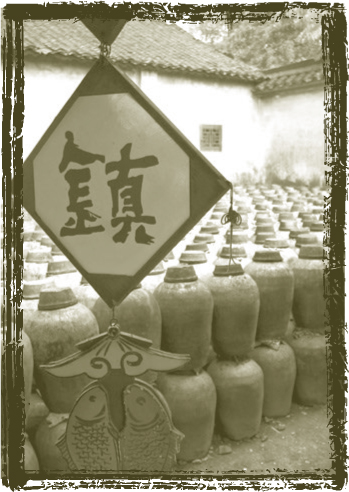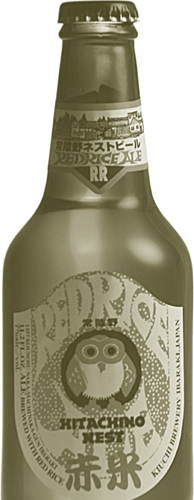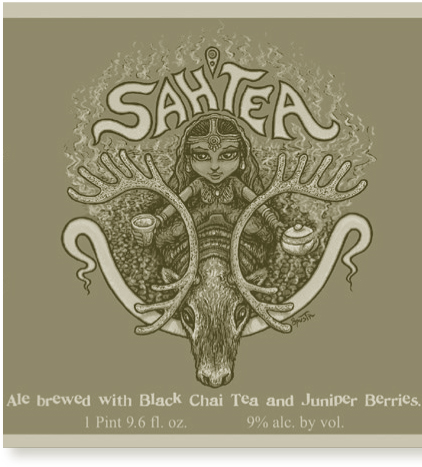
West African Umqombothi beer
The word “traditional” has a somewhat fraught status in the technologically sophisticated world of commercial brewing; it’s usually just marketing gloss to evoke nostalgic images of rustic brewing. The word comes from the Latin traditio, “the act of handing over,” and this pretty well defines true traditional brewing, where knowledge is passed on from generation to generation. Before the twentieth century, most beer was made this way: brewed with locally available ingredients using methods handed down from brewer to apprentice from generation to generation. This kind of brewing was conducted on, at most, a semiprofessional level and evolution was slow and incremental.
Fortunately, commercial beer hasn’t destroyed all vestiges of traditional methods. Africans still brew sorghum beer, Finns strain rye beer wort through juniper, and Southern Indians brew coconut toddy. These beers have been made in similar fashion for generations, and they are sipped in villages where refrigeration is a rarity. Ancestral beer survives even in Europe, sometimes competing in the marketplace with modern lagers and ales. Traditionally made beers have certain features in common, and others that make each one a distinctive product of place. These ancient beers can be found scattered around the world, often outlasting a region’s reputation for having a brewing tradition. ■
THE RICHEST VEIN of traditional brewing runs through Africa, where beer goes by many names—umqombothi, utwala, malwa; it is much the same from Ghana to Ethiopia to South Africa. Indigenous African beer is made the same way it was 2,500 years ago, with sorghum, a grain that flourishes in both temperate and tropical climates. It can survive harsh conditions—salty soil; hot, dry temperatures; even floods—which makes it versatile enough to grow in the continent’s diverse regions.

West African Umqombothi beer
Sorghum is now malted commercially (and because it’s gluten-free, sorghum has gained popularity in the U.S.; see pages 347–349), but traditional African brewers typically malt their own grain on grass mats. Once it has germinated, they dry it rather than kilning it; down the line, this gives the beer a milky white color. Brewers may make all-sorghum beer or add corn, millet, or cassava root to the grist. The mash is more of a soak—it is left to sit overnight in warm water, where it develops a lactic zing in much the way sour mashes do.
The next day, brewers boil the entire mixture and let it cool. Depending on their habit, they may put the sludgy wort into a fermentation vessel then, or instead add more sorghum and let it sit another day (inoculating it with fresh bacteria) and repeat the boil. Finally, brewers put the wort in a covered fermenter and let it ferment spontaneously for a few days. (The brewer judges when it is ready.) The beer is served before fermentation finishes, usually when the beer is around 3 to 4% in strength. It’s cloudy, yeasty, and tart, contains flour residue, and arrives still foaming in the glass.
There are some variations on the method and ingredients. In West Africa, brewers skip the lactic souring stage, so the beer is less tart. In Namibia and Nigeria, millet is the principal grain, though brewers sometimes add sorghum. In different regional variations, brewers flavor their beer with hibiscus, gesho (a shrub used as a bittering agent), banana, and other local fruits and spices. ■
TRY TO CALL TO MIND an Asian style of beer. It’s not easy until you think of the right grain—rice—and then a Japanese sake should materialize in your mind’s eye. Indeed, Asia’s brewing tradition is as old as Europe’s and in some places, equally important.
Where is the world’s oldest ale still produced? Not Belgium or Germany, but China, where a product called huangjiu can trace its lineage back at least 2,500 years. Archaeologists disagree on when this multigrain beer was first made, but the modern beverage, made with rice, millet, and sorghum, is a recognizable descendant. The methods of production and the rituals of consumption attest to the beer’s rich heritage.
For centuries, beer has been celebrated throughout China. In the Tang and Song dynasties, it inspired poetry, music, and painting. Even today, huangjiu remains a part of ritual and tradition. At the birth of a daughter, families bury a strong red variety of huangjiu called nu’er hong and let it ripen for years until her wedding feast. The name is translated as “red daughter” or sometimes “virgin red.” (Boys might get the same treatment, though the beer, known as “scholar red,” is associated with studies, not love.)

Jugs of Chinese huangjiu rice beer
To prepare the rice, brewers steam it to gelatinize it, then acidify it. They steep the grains in warm water and pitch specialized starter cakes (jiuqu) made of yeasts, molds, and bacteria into the porridge. Over the course of a week, the mixture becomes acidic and alcoholic (up to 16% ABV). The final product is filtered, aged, and (usually) pasteurized. Thanks to the varied yeast and bacteria, the flavors of different beers vary widely, from lightly sweet to sharp, musty, and pungent to rich and vinous—some are even salty.
Japanese sake is a closely related beer made entirely from rice. Once a traditional beverage (it dates to somewhere between the third and eighth centuries), it is now fully commercial and refined. The brewing process—similar to the one used to make huangjiu, yet more complex—results in very subtle, flowery beers that are so wine-like that they tend to be grouped more with California whites than German pilsners. At least one company, Japan’s Kiuchi, has done its part to meld the Japanese and European tradition: The sake and beer maker has combined both products to make Red Rice Ale.
In eastern India, handiya (sometimes hadiya) is the local rice beer, and it bears at least a superficial resemblance to sake and huangjiu. Handiya brewers—as in most traditional cultures, almost always women—boil rice (either whole or ground) and add a yeast cake to spark a fermentation that lasts two to five days. The difference between handiya and the rice beers of China and Japan lies in the yeast cake. Indian brewers make the cake, or ranu, from a special preparation of up to two dozen local roots, barks, and plants. The ingredients are ground and held together with previously ground, soaked, and dried rice; in fact, the only yeast in the ball is incidental and environmental. Not only does the ranu add flavor to the finished beer, but some of the ingredients—always a secret mixture designed by the brewer—are added to increase intoxication.

Kiuchi’s Red Rice Ale
Fermented grain is usually called beer, while fermented juice is wine. If you chance to encounter some local indigenous fermented beverage, though, you can’t always trust the translation—Chinese beer, made from rice, is known as wine. In much of Southern Asia, you might encounter something called “beer” that’s made from tree sap. Taxonomically, that’s not precisely correct (it’s more like a mead), but let’s describe it anyway.
Collected from palm and coconut trees, the sap is highly fermentable and will begin active fermentation within hours, when seeded by the fecund air and the yeasts resident in the collecting vessel. Unlike most indigenous ales, the twin processes of acidification and fermentation happen very quickly and sap beer must be consumed the same day it is made; otherwise the souring bacteria will overwhelm the beer and spoil it.
In India, the palm tree gives the drink its name, tadi, and also gave us the word “toddy.” In Indonesia it’s called tuak, in the Philippines tuba. People make palm beer across South Asia and Southeast Asia as well as in Africa—and for a time it was made in South America, too. While Anderson Valley’s Fal Allen was living and brewing in Singapore, he came across a bubbling mug of tuak, which he described this way: “The aroma was of fermented fruit and fresh bread with a hint of decay, and the taste was sharp and citrusy.” ■

In Japan, sake-making is considered an art and the brewmaster (tōji) a fine craftsman.
NORTH AND SOUTH America have a comparatively thin lineage of indigenous beer styles. The cereal grains associated with beer—barley, wheat, rye, and oats—aren’t native to these continents. The Americas did have corn, and by at least 150 BCE people were making beer from it, but beyond that, Native Americans were compelled to look to saps for fermentable sugars. Of the many versions that were once commonplace, only three varieties of ancient corn and sap beers are still in production.
Save for the fact that it’s made from corn, the native beer of the New World is closely related to those brewed in Africa and Asia. Chicha is a cloudy, sourish beverage served young and made largely in domestic or semicommercial volumes. It has been made for over two millennia in much the same way throughout Central and South America.
What distinguishes chicha—and what has given it minor fame among American beer geeks—is its production method. Chicha is made from unmalted corn, and although the old practice has declined sharply, brewers used to chew the kernels in order to produce the enzymes that convert corn starch to sugars. This bizarre and somewhat unappetizing step was taken because human saliva contains the enzymes that would normally be produced in a mash of malted grain, so mashing wasn’t necessary. Instead, brewers—women, overwhelmingly—left little balls of chewed corn to dry in the sun; they boiled these into a loose porridge (which sanitized the saliva), and then left them to spontaneously ferment in earthenware jugs. In three to six days, the chicha became mildly alcoholic (1 to 3% ABV), and they served it fresh and still fizzy with active fermentation.
Now brewers use malted corn called jora and most of the resulting chicha de jora is produced delightfully spit-free. The modern production method, however, stems more from the greater ease of manufacture (and potential volume) than customer squeamishness. Chicha can also be made with yucca root (cassava) or as a nonalcoholic drink (chicha morada).
The paucity of American grains didn’t stop people from conducting experiments in fermentation. They just had to be creative and forage for different kinds of sugars. In the case of pre-Columbian Mexico, the favored source was agave and the resulting drink, pulque. Agave is also the source of mezcal and tequila, but in contrast to those beverages, which use the cooked pulp of the plant, pulque is made with the sap.
Most traditional beers have simple recipes and can be made at home on the stovetop, but pulque is anything but simple. Agave plants must mature for years before they can be tapped, and pulque producers must cultivate fields to feed their production. Once a plant is tapped, it will survive only a few months, having given all the sap it will ever give. In further contrast to most traditional beers, pulque isn’t fermented with wild yeasts, but rather with a bacterium specific to the beverage. Makers seed their sap with finished pulque to begin fresh fermentation and monitor the progress for a week or two until it is at an ideal state of ripeness. Unlike yeasts, the bacteria will continue to eat away at the pulque, eventually ruining it. Modern Mexicans still make pulque, but a number of factors limit it from large-scale production. Waiting a decade for plants to grow to maturity is one bottleneck; but even if there were an unlimited amount of sap, the short window of freshness makes it very hard to package or distribute. It’s also a bit of an acquired taste—if you can get past the viscous, somewhat slimy texture. Good pulque is a bit musty and funky, with a hint of agave—but travelers report finding pulquerias serving mugs of liquid tasting and smelling like rotting fruit. Perhaps for this reason, pulque is often served blended with fresh fruit juice.
Sap beers were not confined just to Central and South America; New England had a version made from maple trees. It was made from the last runnings of sap that were boiled down halfway to syrup, often with hops and sugar or raisins. Brewers fermented it with regular (probably bread) yeast. The style survived through the Depression but is now effectively extinct—though a brewery in Vermont, Lawson’s Finest Liquids, has revived the tradition with periodic small batches. ■
GIVEN THE EXTRAORDINARY technological and commercial advances brewers have made over the past 200 years, it isn’t surprising that traditional brewing has mostly died out in Europe. Yet there are a few surprises to be found at the periphery—namely, in Scandinavia, the Baltics, and Russia. There, brewers have managed to keep techniques alive that would have been common before the introduction of hops (and possibly long before that). Renewed interest in traditional, hand-crafted beer styles has even given them new life in the marketplace.
Thanks to revivals by breweries like Dogfish Head and New Belgium, the secret of Finland’s native beer style is no longer so well kept. Sahti is made of rye and juniper and is known for its odd flavors. But far more odd—and rare and wonderful—are the ancient practices that bring the beer into the world.
Brewers start with a grist of malted barley and 10 to 40 percent malted rye, mashing in wood-fired cauldrons of the kind used in saunas. The brewer brings the temperature up through a series of rough rests or strikes at a single temperature of around 140°F. Then things get interesting. The brewer may bring the whole mash up to the point of boiling here, adding hops and juniper, and sometimes dropping heated stones right into the kettle (creating kivisahti—“stone sahti”). Or the brewer may choose not to boil the beer, skipping directly to the straining phase. This may help answer an old question: Did brewers bother to boil beer before they started using hops? It appears that sahti brewers didn’t—and why would they? Boiling was slow and arduous, and unhopped sahti tasted just as good without it.
Modern breweries use a vessel called a lauter tun to separate wort and spent grain; in sahti-making, this vessel is known as a kuurna and looks quite a bit different. In the past, sahti brewers hollowed out the bole of an aspen tree and lined it with juniper boughs. Now it is more typical to use a similarly shaped stainless-steel trough with steel mesh. The brewer controls the gravity of the beer by sparging—a lot for a lighter beer, less for a heavier one. In the past, brewers collected the first runnings and then sparged to produce a lighter small beer from the second runnings.

Sah’tea, Dogfish Head’s take on Sahti, the traditional Finnish brew, incorporates black tea as well as juniper berries foraged from the Finnish countryside.
In one of its only nods to modernity, today’s sahti is no longer spontaneously fermented—brewers use bread yeast now. Sahti is typically strong—6% ABV and above—and may be a range of pale to brown in color. The flavor is characterized by an unusual blend of banana esters, rye, and juniper, and can taste bready or minty.
An even more ancient—and strikingly simple—method of brewing begins with bread: Add water, let stand, strain, and drink. In a variation, the mixture starts with flour rather than baked bread. This is essentially the method used to make Russian kvass, one of the only traditional beers in the world that is still a widely consumed drink.
Kvass is a handy way to use up stale bread, which may have been how it first gained popularity. The process couldn’t be easier: Makers start by crumbling the bread, then pour boiling water over it. Other ingredients like peppermint or lemon slices may be added for flavor, while raisins or sugar help boost the alcohol content. After the mixture sits for a day, brewers add a packet of baking yeast or use sourdough starter to make it ferment. (Originally, it would have been a spontaneous ferment.) The result—a fizzy, low-alcohol drink—is bottled and sold on street corners. ■